I was a member of the Chukchi Borderlands: Hidden Ocean 2016 expedition, funded through the NOAA Ocean Exploration Program, on board the US Coast Guard Cutter Healy. A majority of the six-week mission was based above the Arctic Circle. This expedition brought together many discipline components to provide a better picture of marine biodiversity and conditions in the Chukchi Borderlands. The Chukchi Borderlands is important in terms of Arctic research because it represents one of the most significant annual ice melt regions in the Arctic, and scientists aren’t sure how changing global climate patterns are currently affecting or will affect organisms in this area. The region is also severely understudied, creating the need to produce a knowledge baseline against which future changes can be evaluated. The research areas were loosely divided into benthos, pelagic system, sea ice microbes, and hydrography. A representative from the U.S. Fish and Wildlife Service recorded data on bird sightings and a marine mammal team collected data on marine mammal sightings. The Chief Scientist on the expedition was Dr. Russell Hopcroft of the University of Alaska, Fairbanks, and my primary researcher was co-chief scientist Dr. Katrin Iken, University of Alaska Fairbanks. I also had access to a multinational team of scientists, students, and technicians. Dr. Iken is a benthic ecologist, and other science perspectives were represented by mid-water ecologists, zooplankton ecologists, microbiologists, and even scientists using isotopes to better understand water cycling. From these perspectives, I was able to view the Arctic from the macro to the micro.
During a conversation early in the expedition, one of the scientists – Dr. Dhugal Lindsay - said, “So little is known…that’s why we are here”, and I have continued to reflect on that statement. Although I expected the work to be challenging and the schedule to be full, to say that the research environment on board the USCGC Healy was intense would be an understatement. We were working in an area difficult to access and using equipment in ever-changing conditions of ice and weather. Between stations and on stations the schedule was always being updated, adjusted, and changed to allow the maximum range of equipment deployments for the given conditions. We were in a remote location where there weren’t any places to get spare equipment, so pre-planning and flexibility were especially important. Even in the face of these challenges, the pieces of the puzzle always came together with a spirit of cooperation amongst team members and a willingness to pitch in wherever and whenever help was needed.
At some point during the expedition I remember thinking, “Here I am, a teacher from a small corner of the world, teaching at an even smaller school, working alongside a team of internationally recognized scientists”. This access and these kinds of experiences are a huge benefit of allowing teachers to participate in science expeditions. A range of equipment supported the science of the expedition, including a box corer, multiple types of nets, CTD, augers, and a remotely operated vehicle (ROV). 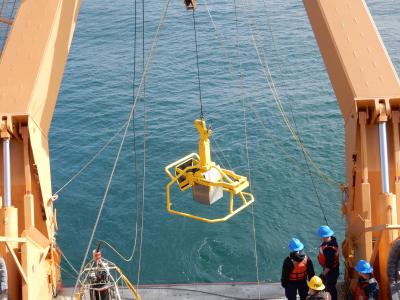
Even the mundane can be exciting. Many years ago, during a chemistry workshop, a comment was made that a teacher might have conducted a lab activity multiple times, but the activity was a first for the students in the room. I was reminded of this each time I sieved mud, recorded data from the CTD, peered through a microscope, or filtered water. The work may have been routine, but it was never boring, and it was exciting to get to use some of the skills that I teach students during classroom instruction. 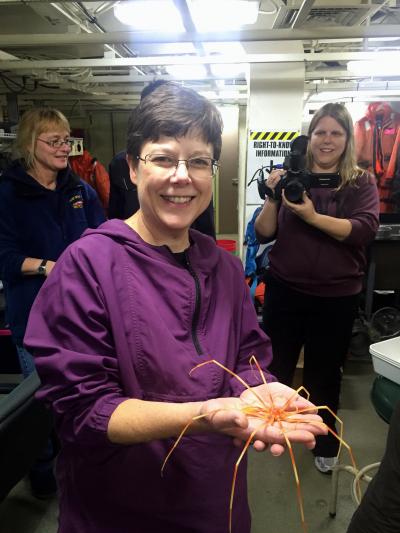
Prior to departure, I knew that I wanted to emphasize connections and comparisons between what is happening in the Arctic and my own community, provide a link through which my students and colleagues may explore the Arctic, and incorporate polar science as a long-term, ongoing part of my school’s science instruction. Because of the broad nature of the research components of the Chukchi Borderlands expedition, I have been able to develop a range of student experiences that bring together both the physical and life sciences over a range of age levels. This is also reflective of the cross-curricular nature of the Next Generation Science Standards.
Students often have the mindset that all science has been explored and discovered; however, the Chukchi Borderlands: Hidden Ocean 2016 expedition illustrated otherwise. From discovery of new organisms to new insights into the behavior of organisms, each experience contributed to a better understanding of the area. When soft-bodied organisms such as jellies and ctenophores are collected using nets or similar tools, their bodies are often destroyed and they all get lumped together. There are few clues about behavior. However, the ROV allowed scientists to observe behavior and spatial distribution in situ. A big surprise was seeing a benthic jelly hanging out on the bottom of the seafloor and brittle stars gracefully “dancing” above the seafloor. Studying pock marks - bowl-like depressions in the seafloor – showed that the distribution of organisms in these areas was different from surrounding areas. I was also reminded of new ways in which technology furthers science through the development of DNA databases that can be used to help identify microbes and soft-bodied organisms.
Focusing on Outreach
Students want to be involved, want to be part of the solution, and have an inherent curiosity about the world around them. My experiences on the Chukchi Borderlands expedition will be invaluable in helping me to promote a better understanding of Arctic science as well as to more effectively address student needs in the science classroom. Furthermore, these experiences have provided me with many tools for classroom exploration of polar science and climate change. Prior to my PolarTREC fellowship I was stymied with how to bring authentic research-based experiences to my classroom. Additionally, as a classroom teacher emphasizing data analysis, I have been able to develop ways of providing students with valid research experiences that more strongly incorporate data collection. 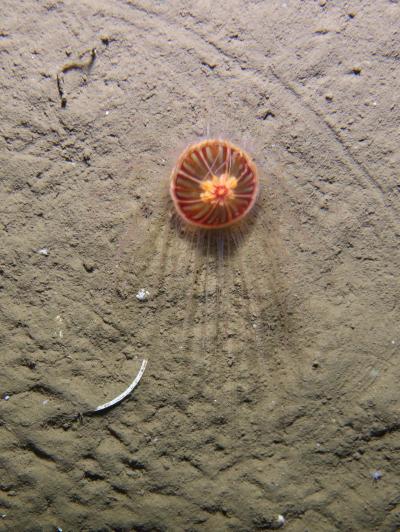
- I have produced a set of activities that allows classroom teachers in grades PK-8 to share polar science with their students. Instructions and materials are located in a tub that is available for loan within my school. New activities are being developed, but the kit currently includes components addressing:
a. Albedo of Ice in which students use light probes to measure reflectivity of ice, liquid water, and other materials. This reinforces student understanding of the negative feedback cycle of ice melt, decreased albedo, and rising temperatures.
b. Blubber Glove consists of three gloves representing different levels of polar bear nutrition. Students are challenged to determine which glove represents the well-fed polar bear, the underfed polar bear, and the starving polar bear.
c. How Do Scientists Work? provides students with opportunities to collect data using a refractometer for salinity, dissolved oxygen probe, pH probe, and a temperature probe.
d. Arctic Food Web/Producers and Consumers allows students to explore some of the organisms found in an Arctic food web and to learn more about the relationship between producers and consumers.
e. Breathe In, Breathe Out models ocean acidification when students blow bubbles (carbon dioxide) into a container of water and then use a cabbage juice indicator to show color changes associated with pH changes. As an extension, students may choose to experiment with clam shells, antacid tablets, and other materials to observe the effects of increased acidity on marine organisms.
- Inspired by PolarTREC orientation, I wrote and received a grant to purchase a carbon dioxide probe for classroom use. I have applied for another grant to purchase additional probes to increase student access. I will be using these probes to facilitate student exploration of carbon cycling by plants and microbes.
- I have put plans in place to regularly monitor water and biological conditions at two locations in my community. Students will be testing salinity, temperature, dissolved oxygen, turbidity, and pH of the water as well as sampling benthic organisms on a monthly basis.
- My interest was captivated by the work conducted by the microbial team during the expedition, and I would like to allocate more classroom instructional time to microbes and extremophiles.
- New lesson plans are being developed to incorporate a cross-curricular cultural component and the use of functional classification.
- I will continue to share my Arctic research experiences with students, colleagues, and community in a range of venues from the classroom to presenting at the Virginia Association of Science Teachers PDI and the National Science Teacher Association Regional Conference.
Personal Growth
I have been asked many times about my favorites. That is a really tough question because I don’t have a single favorite animal or moment. For me, a highlight of the expedition was seeing the diversity of life from microscopic to polar bears. There is ice and it seems like a barren wasteland, but then a container of water or a net or a bucket of mud or even a chunk of ice is brought up, and there is this amazing array of life. It was also remarkable to notice changes in organisms accompanying changes in geography. 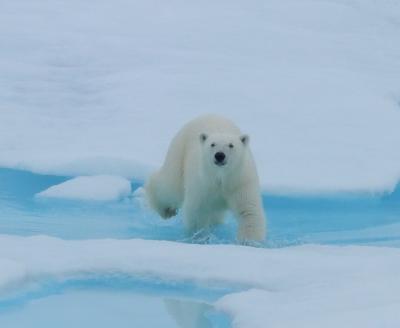
In an age of rapidly changing technology the use of an ROV may seem to be a normal part of scientific exploration, but factors such as cost and availability make access to ROVs less common than one might think. The use of the ROV was a highlight for me and for the scientists on the expedition; providing a rarely seen picture of organisms living in their natural environment. When organisms were brought up in one of the nets or in the box corer, there was none of the grace and beauty observed as those same creatures moved along the seafloor or swam through the water column. The ROV allowed the group to learn more about the distribution and behavior of life below the sea as well as collect samples, and members of the team spent many hours captivated by onscreen images of anemones, pycnogonids, dumbo octopuses, brittle stars, and benthic shrimp. The ability to collect specimens was another huge bonus of using an ROV. Imagine trying to slurp up a moving animal from a moving ROV attached to a moving boat or trying to pluck a delicate anemone from the seafloor without crushing it. I was as much in awe of the skill and communication required to maneuver the ROV and collect specimens as I was with the images and specimens themselves.
From getting there to working there, the Arctic is a difficult location in which to conduct research; yet, if we view Earth’s connectedness in terms of a global ecosystem, we are all linked to the Arctic through our actions and the actions of a global community. I was privileged to have had the opportunity to work with an amazing group of scientists, students, and technicians as a contributing member of the research team, and I look forward to continuing to share these experiences within my classroom, my community, and with colleagues. I hope that in some small way I will play a role in inspiring a student to stretch his or her own science wings on this amazing planet.
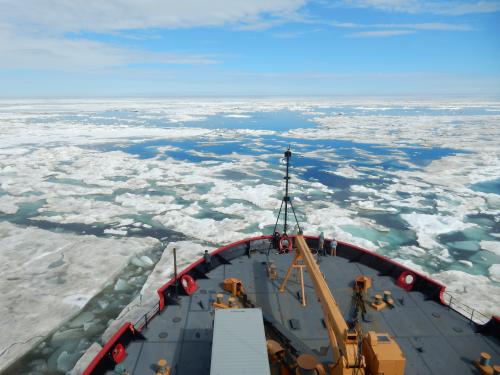
| Attachment | Size |
|---|---|
| Download Report (1.04 MB)1.04 MB | 1.04 MB |
This program is supported by the National Science Foundation. Any opinions, findings, and conclusions or recommendations expressed by this program are those of the PIs and coordinating team, and do not necessarily reflect the views of the National Science Foundation.
